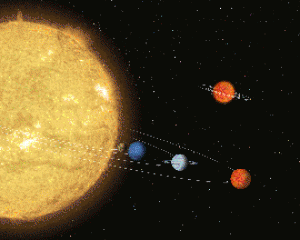As if we didn’t already have enough trouble defining what a planet is, astronomers have now discovered a brown dwarf only eight times the mass of Jupiter. Surrounded by a dusty disk, the object is actually smaller than a number of planets already known to be orbiting other stars. Any miniature solar system that formed around the brown dwarf would be roughly 100 times smaller than our own. All of which raises the question of what to call objects that might be found around this tiny dwarf: planets or moons?
The question has obvious resonance in an era marked by repeated discoveries in the Kuiper Belt that could be considered of planetary size. And another sign of the ambiguity in definition is that worlds like Titan, Ganymede and Callisto are large enough in their own right to qualify as planets, if we overlook the inconvenient fact that they orbit massive planets of their own. The question may seem insignificant, but how we define things is ultimately a measure of how extensive our knowledge has become, and this issue shows us that we have a long way to go in understanding how and where planets form.
“There are two camps when it comes to defining planets versus brown dwarfs,” said Giovanni Fazio of the Harvard-Smithsonian Center for Astrophysics, a member of the discovery team. “Some go by size, and others go by how the object formed. For instance, this new object would be called a planet based on its size, but a brown dwarf based on how it formed.”
 The new brown dwarf, called Cha 110913-773444, is located some 500 light years from Earth in the constellation Chamaeleon. A number of observing sites contributed to the find, but it took the Spitzer Space Telescope’s Infrared Array Camera to pick out the dim protoplanetary disk. As to the disk itself, the team speculates that it would be sufficient to form a small gas giant and several Earth-sized rocky planets, as depicted in the illustration.
The new brown dwarf, called Cha 110913-773444, is located some 500 light years from Earth in the constellation Chamaeleon. A number of observing sites contributed to the find, but it took the Spitzer Space Telescope’s Infrared Array Camera to pick out the dim protoplanetary disk. As to the disk itself, the team speculates that it would be sufficient to form a small gas giant and several Earth-sized rocky planets, as depicted in the illustration.
Image (click to enlarge): This artist’s conception compares a hypothetical solar system centered around a tiny “sun” (top) to a known solar system centered around a star, called 55 Cancri, which is about the same size as our Sun. The tiny system consists of an unusually small “failed” star, or brown dwarf called Cha 110913-773444, and a surrounding disk of gas and dust that might one day form planets. At a mass of only eight times that of Jupiter, the brown dwarf is actually smaller than several known extrasolar planets. The largest planet in the 55 Cancri system is about four Jupiter masses. Credit: NASA/JPL-Caltech.
The work on Cha 110913-773444 was performed by a team led by Kevin Luhman of Penn State University. A paper on its findings will appear in the December 10 issue of The Astrophysical Journal Letters. And here is a news release from the Harvard-Smithsonian Center for Astrophysics.

